by Ken Butigan
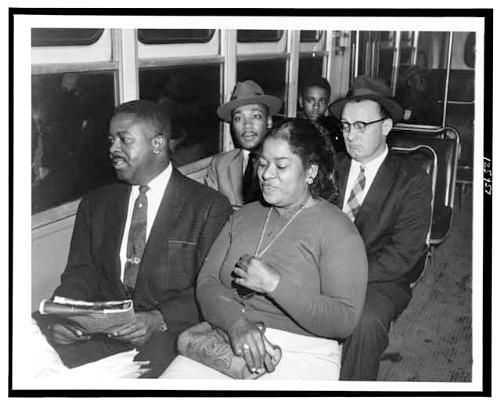
Ralph Abernathy, Martin Luther King, Smiley and unidentified woman, 1956 Bus Boycott; courtesy wagingnonviolence.org
During a visit years ago to the Rock and Roll Hall of Fame in Cleveland, Ohio, I spent a lot of time at an exhibit where you could track the heredity of rock bands. Monitors displayed a family tree detailing what groups had influenced which bands. You could trace how particular acts had inherited, adapted or transformed genres, styles and musical innovations. For example, the Rolling Stones, to the best of my foggy recollection, were influenced by Muddy Waters, Robert Johnson, and Buddy Holly, as well as by Roy Orbison and the Kingston Trio. If even one of those ancestors was out of the mix, the Stones might have sounded very different — or maybe wouldn’t have formed in the first place.
Read the rest of this article »
by Richard B. Gregg

The Wheel of Integral Non-violence is courtesy of chico-peace.org
Editor’s Preface: This 1941 article, with its Foreword by Gandhi, continues our series of important historical documents on the theory and history of Gandhian nonviolence. Gregg here argues for the value of manual labor, as advocated by John Ruskin, and as practiced by Gandhi in his ashrams, where Gregg had lived. Gandhi considered spinning and weaving essential to the routine of a nonviolent community, yet this article is one of the very few to try to explicate this. Please also see the Editor’s Note at the end for more information about Gregg, and please also consult his other article, which we have posted here. JG
Foreword (by M. K. Gandhi): ‘A Discipline for Non-violence’ is a pamphlet written by Mr. Richard B. Gregg for the guidance of those Westerners who endeavour to follow the law of Satyagraha. I use the word advisedly instead of ‘pacifism’. For what passes under the name of pacifism is not the same as Satyagraha. Mr. Gregg is a most diligent and methodical worker. He had first-hand knowledge of Satyagraha, having lived in India and then too for nearly a year in the Sabarmati Ashram. His pamphlet is seasonable and cannot fail to help the Satyagrahis of India. For though the pamphlet is written in a manner attractive for the West, the substance is the same for both the Western and the Eastern Satyagrahi. A cheap edition of the pamphlet is therefore being printed locally for the benefit of Indian readers in the hope that many will make use of it and profit by it. A special responsibility rests upon the shoulders of Indian Satyagrahis, for Mr Gregg has based the pamphlet on his observation of the working of Satyagraha in India. However admirable this guide of Mr. Gregg’s may appear as a well-arranged code, it must fail in its purpose if the Indian experiment fails. (Sevagram, 24-8-1941)
A Discipline for Non-violence
For ages military discipline has won and held men’s faith. However crude, indiscriminate, and brief may be the results of organized violence, the world still has immense respect for its show of firmness and order. Much as we dislike war, when we begin to ask how we can attain justice and peace, we come face to face with this power of the military method. What is the secret of this power? Does it lie merely in men’s fear of violence?
Read the rest of this article »
by Diane Lefer

Poster art courtesy fabiusmaximus.com
Editor’s Preface: Martin Luther King, Jr. called James Lawson “the world’s leading theorist and strategist of nonviolence.” To Congressman John Lewis, he is “the architect of the nonviolence movement.” Jesse Jackson calls him simply “the Teacher.” According to author David Halberstam, in his study of the Civil Rights Movement, The Children he was as responsible for sowing the seeds of change in the South as any single person, except perhaps Martin Luther King. This is the third in our series of interviews with Rev. Lawson. Please see the note at the end for further information, and acknowledgments. JG
Diane Lefer: You’ve said we have sufficient activism in this country to have a better country than we have. What are we getting wrong?
James Lawson: Activism has not been appropriating and practicing enough the Gandhian science of social change. What Gandhi called nonviolence or satyagraha – soul force – is both a way of life and a scientific, methodological approach to human disorder. It is as old as the human race and can be found in the oral and written history of the human family from way back. Then Gandhi began to put together the steps you need to take to create change. He is the father of nonviolent social change in the same way that Albert Einstein is the father of 20th-century physics – not the inventor, but the person who pulled it together.
Read the rest of this article »
by Nathan Schneider
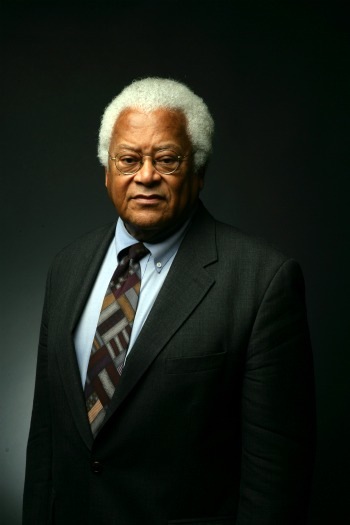
Portrait of James Lawson courtesy Vanderbilt University, vanderbilt.edu
Editor’s Preface: James Lawson was one of the chief organizers of the Civil Rights Movement, especially of the Nashville lunch-counter sit-ins. Throughout his long career he has steadfastly emphasized the need to develop long-range nonviolent strategies, not just short-term tactics. Please see the note at the end for further information about Lawson, Nathan Schneider, links, and acknowledgments. JG
Nathan Schneider: For activists trying to reclaim people’s power among all the powerful corporations at work today, what do you think can be learned from the civil-rights movement? What are the lessons from your experience?
James Lawson: Well, I think that the main thing that activists must learn is nonviolent philosophy, methodology, techniques, and strategy. They need to work from an investigation and assessment of their local base, determining thereby the skills and techniques that will organize and mobilize people in that local scene. No social movement is going to take place if it doesn’t have roots in what’s going on in Cleveland, Ohio, or Washington, DC, or right across Georgia. That’s how movements take place, and that’s how movements have taken place in the United States—not by national policy, but by local groups assessing their own scene and trying to be real about how to start working.
At the local level, people need to get some processes going that will cut down the sales of certain companies and corporations and begin to send a mighty message. It may not be possible to do that in the first year, but I’d be willing to wager that steady organizing around something specific would begin to have an impact. That’s the first task.
Read the rest of this article »
by Brian Martin
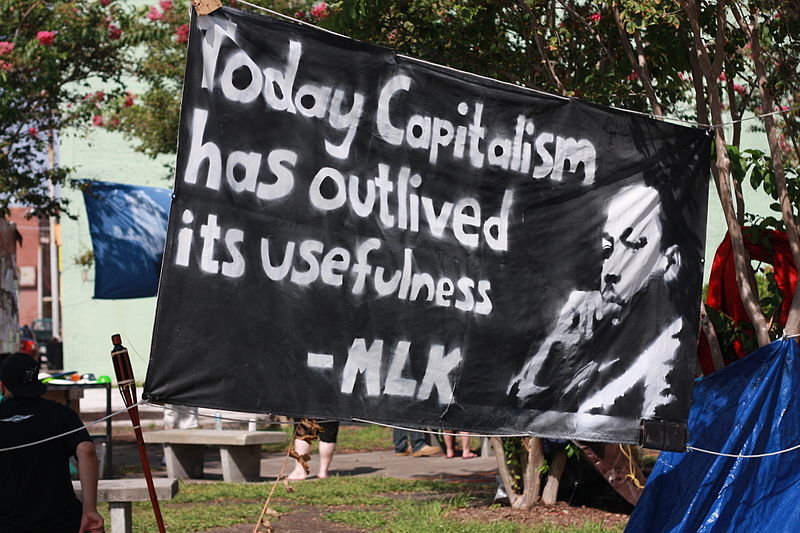
Martin Luther King banner at 2012 U.S. Republican Convention, courtesy commons.wikimedia.org
Nonviolent action provides the best hope for moving beyond capitalism to a more humane social and economic system. In the past, methods of nonviolent action such as strikes, boycotts, non-cooperation, sit-ins and alternative institutions have most commonly been used to challenge systems of direct violence, such as repressive governments. Capitalism is a more difficult system to challenge using nonviolent action because of the way it infiltrates people’s everyday thinking and behaviour. In order to develop a nonviolence strategy against capitalism, a careful analysis is required to pinpoint key areas for attention, spell out alternatives and highlight opportunities. At the core of capitalism is private ownership of the means of production, including land, factories and knowledge. This is backed up, ultimately, by the coercive power of the state. Problems with capitalism are well known, so only a summary is given here. Generally speaking, the system of ownership encourages individuals and groups to put special interests above general interests.
Read the rest of this article »
by Terry Messman

John Lewis at Nashville sit-in, book cover of March: Book One, courtesy topshelfcomix.com
Editor’s Preface: John Robert Lewis (b. 1940) is the U.S. Representative for Georgia’s 5th congressional district, and the dean of the Georgia congressional delegation. His district also includes the northern three-quarters of Atlanta. His Wikipedia page is a reliable starting point for information about his nonviolent civil rights activities and his political career. JG
It has now been 50 years since “Bloody Sunday” in Selma, Alabama, when John Lewis and Hosea Williams led some 600 civil rights marchers across the Edmund Pettus Bridge on March 7, 1965. The demonstrators attempted to march peacefully from Selma to Montgomery in support of voting rights, but state and local police viciously attacked the nonviolent procession, brutally beating them with whips and clubs, firing tear gas and charging the defenseless marchers on horseback. Hundreds of people suffered bloody beatings and some were clubbed nearly to death.
Read the rest of this article »
by Jess Clarke

Homeless in America; image courtesy web.stanford.edu
Interviewer’s Preface: Street Spirit is one of the longest-lived publications on poverty, homelessness and human rights in the United States; it is sold by homeless vendors in Oakland and Berkeley, California, and tirelessly defends the human rights of homeless people. Terry Messman produced the first issue in March 1995, and has edited and designed every issue for nearly 22 years. Please see the note at the end for further biographical details about Messman, and interviewer Jess Clarke. JC
“What matters in the long run is staying true to the cause of justice. In the end,
that is the very meaning of our lives — whether we keep going, and keep working for peace and justice,
or give up in despair. It’s the question at the very heart of it all.” Terry Messman
Jess Clarke: As the founder of Street Spirit, you’ve seen some of the important political trends in homeless organizing and human rights advocacy in the Bay Area. Looking at the big picture, when and why did you first found Street Spirit?
Terry Messman: We put out the first issue in March of 1995, so we’ve been going steadily nearly 22 years. It’s one of the longest-lived media of any kind in the nation to document the history of poverty, homelessness, and the movements to overcome economic injustice.
Read the rest of this article »
by Mohinder Singh
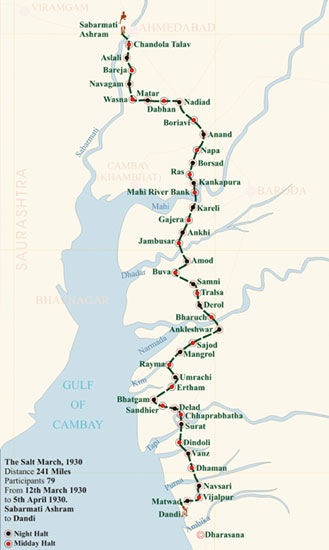
Map of Gandhi’s salt march courtesy indiansaltmarch.weebly.com
Editor’s Preface: Gandhi’s Salt March was one of his most significant nonviolent civil resistance campaigns, yet without knowing some of the historical significance of salt his symbolic gesture of gathering a handful cannot be understood. For further reflections on Gandhi and salt see also the article ”Salty Gandhi” by William J. Jackson posted here. The note at the end has further information and acknowledgments. JG
The German scholar M.J. Schleiden in his book Das Salz (Leipzig, 1875) contended that there was a direct correlation between salt taxes and despots. Athens did not tax salt, but China and Mexico were salt-taxing tyrannies. Using the salt-taxation yardstick, British rule in India was patently despotic.
Salt taxation originated in China. The earliest known written text on salt regulation is the Chinese Guanzi: On Weighing and Balancing Economic Factors (c. 300 B.C.). It argued that people cannot do without salt, and in their desperation would be willing to pay a high price; it states ‘Coastal states dependent upon the resources of the ocean should cautiously and reasonably establish a tax on salt.’ In due course, this proposal became the adopted policy of the Chinese emperors and the first known instance of a state-controlled monopoly of a vital commodity. The revenues from salt taxation were used to build not only armies but also defensive structures such as the Great Wall. At one time over half of the state’s revenue was derived from salt. Any popular manifestation of resentment against it was handled with an iron fist.
Read the rest of this article »
by Mulford Q. Sibley
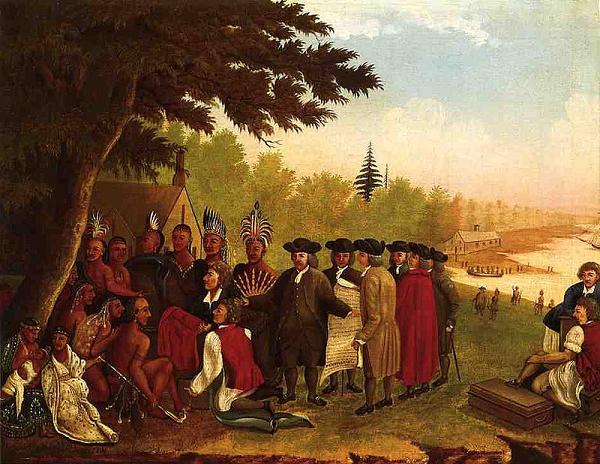
Edward Hicks, “William Penn’s Peace Treaty with the Indians”; courtesy en.wikipedia.org
Editor’s Preface: Mulford Sibley wrote this article in the early 1960s as his contribution to the scarce anthology Gandhi: His Relevance for our Times, edited by G. Ramachandran and T. K. Mahadevan, New Delhi: Gandhi Peace Foundation, 1962. Please see the Editor’s Note at the end for further information about Sibley, and acknowledgments. JG
American culture, it is sometimes said, has been peculiarly violent, both in outlook and in practice. It has exalted physical force, praised rough action, and placed in the forefront such cynical statements as “Fear God and keep your powder dry.” One of America’s leading Presidents Theodore Roosevelt is well known for his advice to “speak softly but carry a big stick.” (1) Violence has been associated with the frontier spirit, the Westward movement treatment of the American Indian, the rise of business corporations, and the development of labor organizations. Violent crimes are more numerous proportionately than in most other nations of the world; and the police, by contrast with those in Britain, are heavily armed. Popular culture, moreover, if we are to take radio, television, cinema, and pulp magazines as indicators, exults in violence.
Read the rest of this article »
by Terry Messman

Album cover art courtesy allmusic.com
“We’re still struggling as a species with how we can stop war. The families (of Vietnam veterans) were so grateful that anybody would acknowledge their sacrifice. And I don’t mean sacrifice in a clichéd way. The war had reached out and struck their family in a horrible, terrible way.” Country Joe McDonald
Street Spirit: You have been deeply involved in supporting military veterans, but there’s a saying that no good deed goes unpunished. Did Bill O’Reilly of Fox News actually compare you to Fidel Castro because you organized a Veteran’s Day event in 2005 that involved the Gold Star Families for Peace?
Country Joe McDonald: Yeah, he did that! He did say that! He said on his show that me doing a Veteran’s Day event in Berkeley was like having Fidel Castro in charge of it, after we got publicity because we wanted to have a Gold Star father speak in one of our Veteran’s Day events.
Read the rest of this article »














